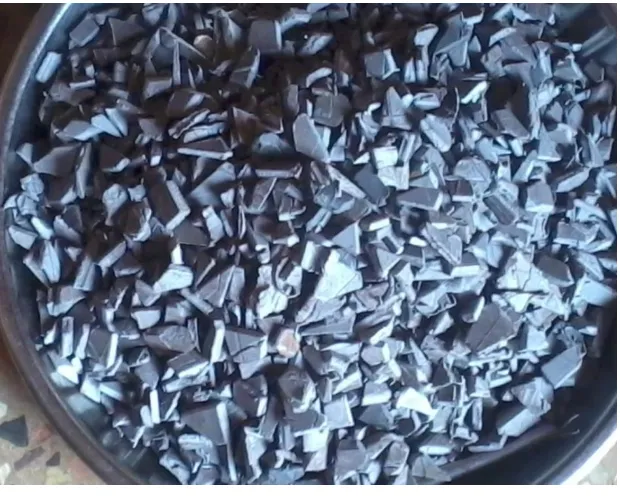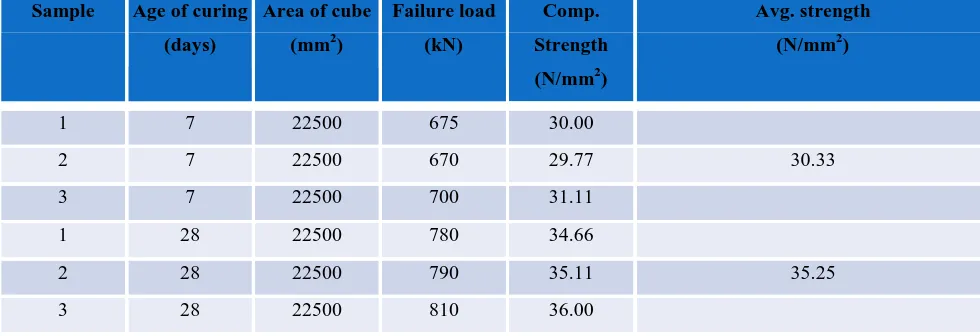Copyright to IJIRSET DOI:10.15680/IJIRSET.2015.0412114 12315
Compressive Strength of Concrete using
Plastic Waste
Manikandan.P
1, Senthamilkumar.S
21
Ph.D Scholar, Dept. of Civil Engineering, Periyar Maniammai University, Vallam, Thanjavur, Tamilnadu, India
2
Professor, Dept. of Civil Engineering, Periyar Maniammai University,Vallam, Thanjavur, Tamilnadu, India
ABSTRACT: In developing countries the major problems concern by the using of plastics products. These plastics are non biodegradable materials such as toxic and inorganic materials. If those plastics are stored or dumping in any open sites it will cause the major environmental problems. Using this plastic waste or recycling. This waste into the useful products means the quality of wastage will reduce. In construction wise plastics are used as fine aggregate and coarse aggregate in concrete. Here the polypropylene plastics are replaced as a fine aggregate and coarse aggregate at a percentage of 5, 7, 9 at the grade M20 concrete. Finally this study shows the results of compressive strength of concrete cubes using a plastic waste in M20 grade of concrete.
KEYWORDS: Plastics, Polypropylene, Compressive strength, M20 grade concrete
I. INTRODUCTION
Plastic waste is a material consisting of a synthetic of semi- synthetic organics. Plastic product in the environment that adversely affects the human, wildlife, etc.The lands gets littered by plastic bag garbage presenting an ugly and unhygienic seen. This littering reduces the rate of rain water percentage and low water levels in every city.
In last two decades in US PET bottles and jars are produced up to 16%.Compare to other product materials and also HDPE the natural bottles also manufacture up to 4.9%.In India 0.24 into the million tones of plastic dumped into the ocean every year. The amount of plastic waste per year is 0.6 million tones. At December 2014 estimated the quantity of plastic floating in the ocean at nearly 270000 tones. So that the plastics should be recycled in proper manner. If plastic used in construction wise 0.5% of plastic shell be reduced. This is also one of the ways of safe disposal of plastic waste.
II. PROPERTIES OF PLASTICS
Table 1: Properties of Waste Plastics
Type of plastics Polypropylene
Density of waste plastics 0.93 to 0.97 g/cm3
Copyright to IJIRSET DOI:10.15680/IJIRSET.2015.0412114 12316
III. EXPERIMENTAL RESULTS
1. SCRAPED PLASTICS
Fig 1: Scraped Plastics
Percentage of plastics (Granular shape) to minimize F.A
For 5% = 110gms
For 7% = 154gms
For 9% =198gms
Table 2: Compressive Strength of Concrete Cubes (Adding 5% of plastic)
Sample Age of
curing(Days)
Area of
cube(mm2)
Failure load
kN
Comp. strength
N/mm2
Avg. strength
N/mm2
1 7 22500 560 24.88
2 7 22500 560 24.88 25.17
3 7 22500 580 25.77
1 28 22500 660 29.33
2 28 22500 690 30.66 30.51
Copyright to IJIRSET DOI:10.15680/IJIRSET.2015.0412114 12317
Table 3: Compressive Strength of Concrete Cubes (Adding 7% of plastic)
Sample Age of curing
(Days)
Area of cubes
(mm2)
Failure loads
kN
Comp.
Strength
N/mm2
Avg.
Strength
N/mm2
1 7 22500 615 27.33
2 7 22500 610 27.11 27.45
3 7 22500 628 27.91
1 28 22500 680 30.22
2 28 22500 725 32.22 32.15
3 28 22500 765 34.00
Table 4: Compressive Strength of Concrete Cubes (Adding 9% of plastic)
Sample Age of curing
(Days)
Area of cubes
(mm2)
Failure loads
kN
Comp.
Strength
N/mm2
Avg.
Strength
N/mm2
1 7 22500 650 28.88
2 7 22500 730 32.44 31.99
3 7 22500 780 34.66
1 28 22500 800 35.55
2 28 22500 845 37.55 37.10
Copyright to IJIRSET DOI:10.15680/IJIRSET.2015.0412114 12318
Fig 2: Failure Load of Concretes with Scraped Plastics
2. CRUSHED PLASTICS (High Density)
Fig 3: Crushed Plastics (High Density)
Percentage of plastics (Crushed shape) to minimize C.A
For 5% = 220gms
For 7% = 308gms
For 9% =396gms 0 5 10 15 20 25 30 35
7 Days 28 Days
Fai
lur
e
load
Age of concrete
Copyright to IJIRSET DOI:10.15680/IJIRSET.2015.0412114 12319
Table 5: Compressive Strength of Concrete Cubes (Adding 5% of plastic)
Sample Age of curing
(days)
Area of cube
(mm2)
Failure load
(kN)
Comp.
Strength
(N/mm2)
Avg. strength
(N/mm2)
1 7 22500 640 28.44
2 7 22500 630 28.00 28.07
3 7 22500 625 27.77
1 28 22500 710 31.55
2 28 22500 725 32.22 32.21
3 28 22500 740 32.88
Table 6: compressive Strength of Concrete Cubes (Adding 7% of plastic)
Sample Age of curing
(days)
Area of cube
(mm2)
Failure load
(kN)
Comp.
Strength
(N/mm2)
Avg. strength
(N/mm2)
1 7 22500 640 28.44
2 7 22500 660 29.33 29.00
3 7 22500 655 29.24
1 28 22500 720 32.00
2 28 22500 760 33.77 33.33
3 28 22500 770 34.22
Table 7: Compressive Strength of Concrete Cubes (Adding 9% of plastic)
Sample Age of curing
(days)
Area of cube
(mm2)
Failure load
(kN)
Comp.
Strength
(N/mm2)
Avg. strength
(N/mm2)
1 7 22500 675 30.00
2 7 22500 670 29.77 30.33
3 7 22500 700 31.11
1 28 22500 780 34.66
2 28 22500 790 35.11 35.25
Copyright to IJIRSET DOI:10.15680/IJIRSET.2015.0412114 12320
Fig 4: Failure Load of Concretes with Crushed Plastics
IV. RESULTS AND CONCULSIONS
The strength of M20 grade of concrete using scraped plastics at 9% was 37.10 N/mm2 at 28 days curing period
Using crushed plastics ( High Density) the compressive strength of concrete cubes at 9% was 35.25 N/mm2
Compare to crushed plastics the strength of scraped plastic concrete was high
Plastics are added additionally to the concrete as coarse aggregate at the percentage of 5, 7 and 9.
The compressive strength of the plastic concrete was high compare to the conventional concrete
Using waste plastics into the concrete means the strength of the concrete is high up to 50% to 70%.
REFERENCES
1. Amiya Akram, C. Sasidhar, K. Mehraj Pasha “E-Waste Management by Utilization of E-Plastics in Concrete Mixture as Coarse Aggregate
Replacement”Vol. 4, Issue 7, July 2015
2. R. Kandasamy and R. Murugesan( 2011), “ Fibre Reinforced Concrete Using Domestic Waste Plastics As Fibres” ARPN Journal of
Engineering and Applied Sciences , VOL. 6, NO. 3, MARCH 2011
3. Iftekar gull, M. Balasubramanian, K.S.anandh, K.vetrivel “An experimental investigation on use of post consumed e- plastic waste in concrete”
Vol.2., Issue.2., 2014
4. R.Lakshmi, S. Nagan (2011), “Investigations On Durability Characteristics Of E-plastic Waste Incorporated Concrete” Asian Journal Of Civil
Engineering (Building And Housing) Vol. 12, No. 6 (2011) Pages 773-787
5. R.Lakshmi, S. Nagan, “Utilization of waste E plastic particles in cementitious mixtures” Journal of Structural Engineering,Vol.38, No. 1, April
– May 2011, pp. 26-35.
6. P.k. Roy, Devansh jain, Vijay meshram“Use Of Electronic Waste As A Partial Replacement Of Coarse Aggregate In Concrete” International
journal of engineering research, vol 3, issue 4, 2015
7. P.Krishna Prasanna, M.Kanta Rao “Strength Variations in Concrete by Using E-Waste as Coarse Aggregate” IJEAR Vol. 4, Issue Spl-2, Jan -
June 2014
8. G. Gaidajis, K. Angelakoglou and D. Aktsoglou,“E-waste: Environmental Problems and Current Management” Journal of Engineering Science
and Technology Review 3 (1) (2010) 193-199. 0
5 10 15 20 25 30 35
7 Days 28 Days
Fai
lur
e
load
Age of concrete
5%
7%





